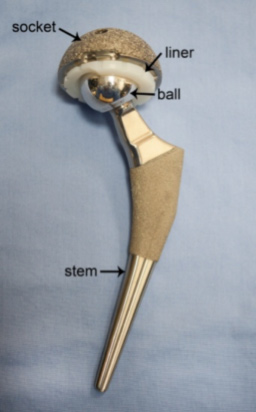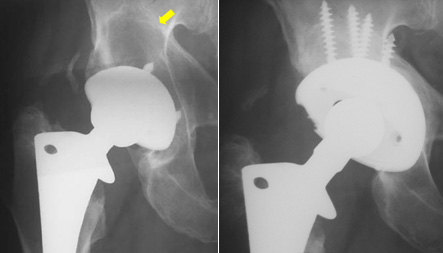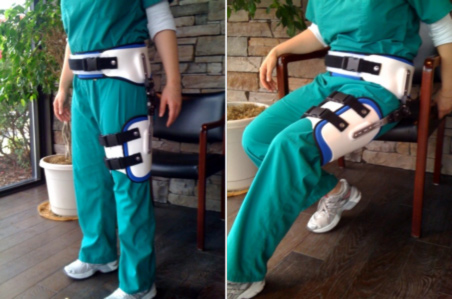
Total hip implant demonstrating socket, liner, ball and stem
Total hip replacement or total hip arthroplasty is a surgical procedure in which an artificial hip joint (prosthesis) is implanted to replace an arthritic or damaged joint. A hip replacement includes an artificial hip socket and femoral stem with an attached femoral head (picture at right).
Hip replacement surgery is very effective in relieving pain and improving patient function and quality of life. However, hip replacements may “wear out” or fail for other reasons, and occasionally require a “hip revision surgery.” In hip revision surgery, the worn out or failed prosthesis is replaced with a new hip implant.
The Purpose of Hip Revision Surgery
Hip revision surgery is performed to replace a worn out, loose, painful, or infected prosthesis. The goals of surgery are to relieve pain, improve function, and enhance overall quality of life.
Reasons for Hip Revision Surgery
There are several reasons you might need hip revision surgery.
- The prosthesis may wear out. Most commonly, the plastic lining of the socket wears out and needs replacement.
- There may be bone loss around the prosthesis. As the hip replacement wears out, implant particles are released and can stimulate bone loss around the prosthesis.
- The prosthesis may be loose. Over long periods of time, hip implants can loosen and cause pain leading to the need for revision surgery.
- The prosthesis may be unstable with recurrent dislocation (ball popping out of the socket) and pain.
- Although uncommon, the prosthesis can become infected. This problem requires treatment to remove the prosthesis, cure the infection and re-implant a new prosthesis.
Who Should Undergo Hip Revision Surgery?
Patients with the conditions described above should consider hip revision surgery. Of course, the decision to pursue surgery is made in conjunction with Dr. Clohisy. Most patients undergoing revision surgery have pain and discomfort in the hip that limits function and negatively impacts overall quality of life.
What is Hip Revision Surgery Like?
Hip revision surgery is similar to primary hip replacement surgery but the procedure is more complicated and lasts longer. Every patient and every hip revision surgery is unique. The details of surgery vary from patient to patient and depend upon the type of prosthesis failure. The procedure may take two to four hours and a variety of techniques may be used in the revision surgery. These include:
- Removal of the old prosthesis (cup, liner, stem and/or femoral head)
- Preparation of the bone (socket and femur) for the new implant
- Bone grafting in areas of bone loss (if needed)
- Implantation of the new prosthesis
Sometimes hip revision surgery is needed because the plastic lining of the socket is worn, but the socket and stem are well-fixed and in good condition. In such cases, the socket liner and femoral head are exchanged to new implants (this procedure is called a head and liner exchange).
If you have an infection, your surgery will be done in two stages. In the first stage the infected prosthesis and tissues are removed and the infection is treated with antibiotics. The second stage consists of re-implantation of the new prosthesis.
Every hip revision surgery is unique, so discuss the details of the procedure, your recovery plan and any concerns with Dr. Clohisy and his staff.
What are the Benefits of Hip Revision Surgery?
Most patients who have hip revision surgery report that it eliminates or diminishes pain, improves function, and quality of life. It commonly corrects leg length inequalities and improves the patient’s ability to walk. After recovery, the majority of patients who have hip revision surgery are satisfied with their improved quality of life (see below).

Hip x-rays of a 62-year-old male patient with severe pain and wear of the hip prosthesis. There is major bone loss around the socket before revision surgery (arrow). This patient had hip revision surgery to replace the lost bone and to implant a new prosthetic socket. The new socket is secured with screws to provide stable fixation. He had an excellent result from surgery with complete relief of pain.
What are the Risks of Hip Revision Surgery?
Although most patients do not have complications with surgery, any procedure carries some degree of risk for complications. In hip revision surgery, these risks include, but are not limited to, bleeding, infection, blood clots, fracture, nerve palsy, leg length inequality, pulmonary embolism, implant loosening, dislocation of the prosthesis, heart attack and stroke. You should speak to Dr. Clohisy about these potential risks and any other concerns you have regarding your surgery.
Recovery
The recovery or rehabilitation process following any joint replacement is crucial to your long-term success. Recovery from hip revision surgery is more involved than recovery from a primary hip replacement. The recovery phase is also quite variable due to the variability in the surgical techniques used for different patients. Most patients undergo a two to four month rehabilitation program supervised by a physical therapist. Weight bearing on the surgical hip is commonly restricted for six to eight weeks. A hip abduction brace (picture below) is commonly used to prevent early dislocation of the prosthesis. Daily strengthening exercises are an important part of the recovery. The therapist will also assist the patient in return to walking, sitting, transferring in and out of a car, placing shoes and socks and other functional activities. Dr. Clohisy and his office staff can answer any questions you have about your recovery program.

Hip abduction brace in standing and seated positions.